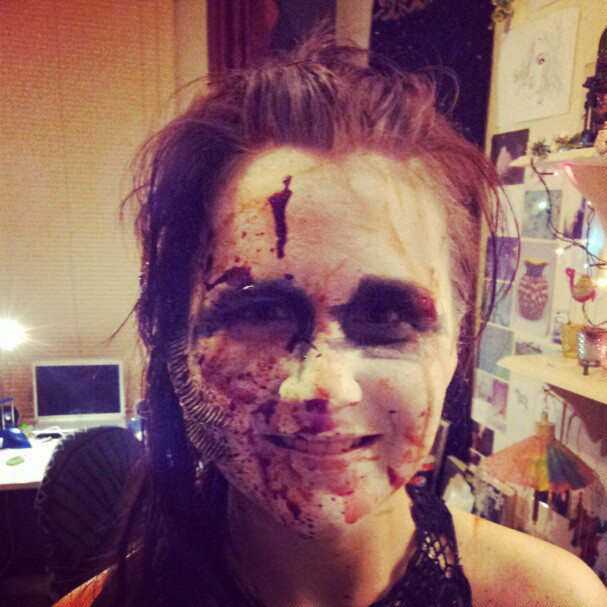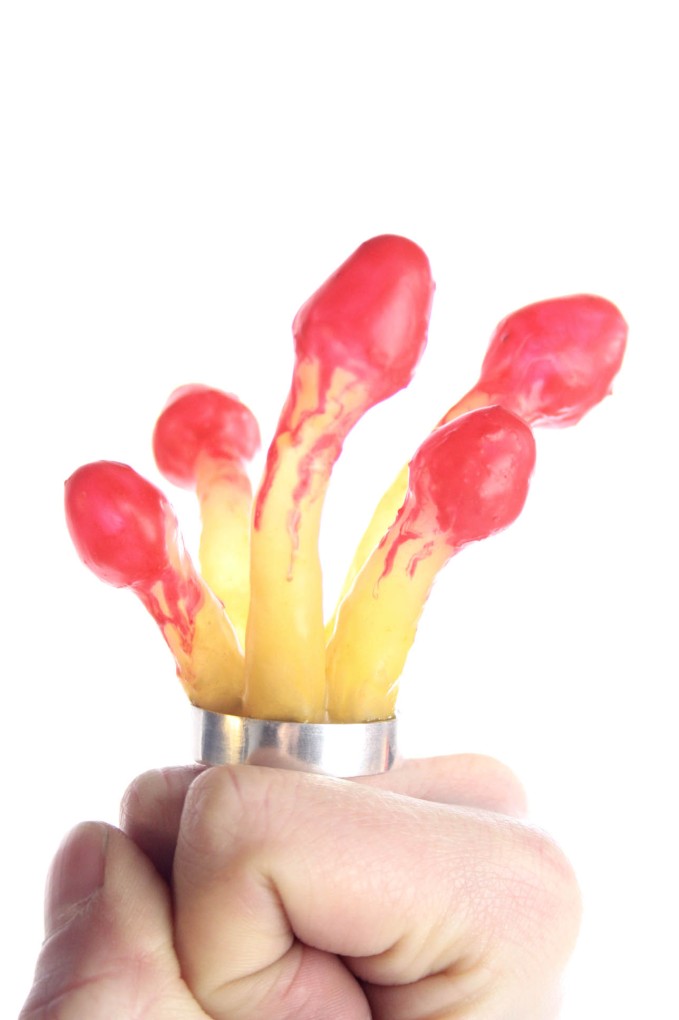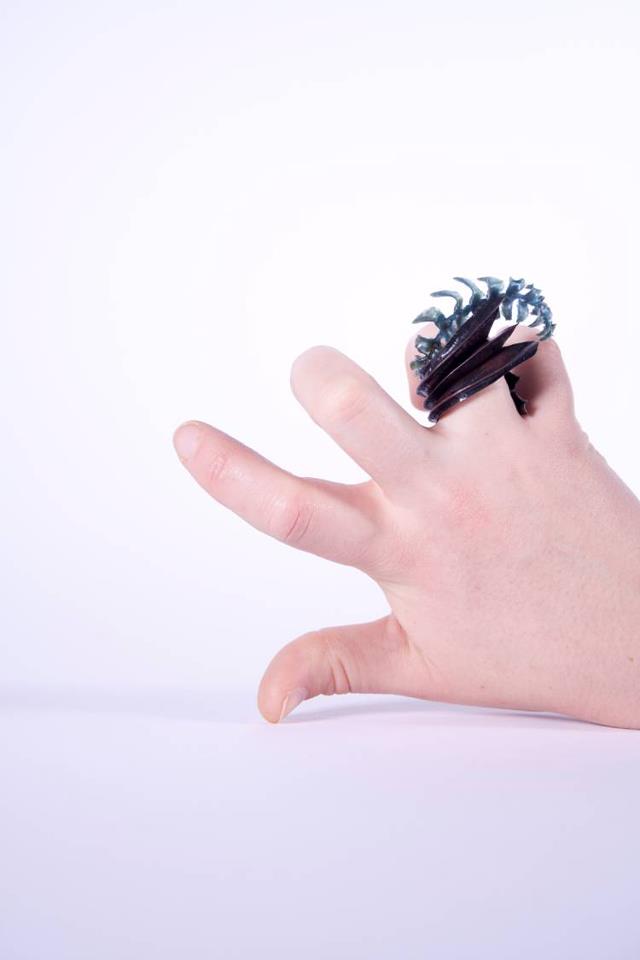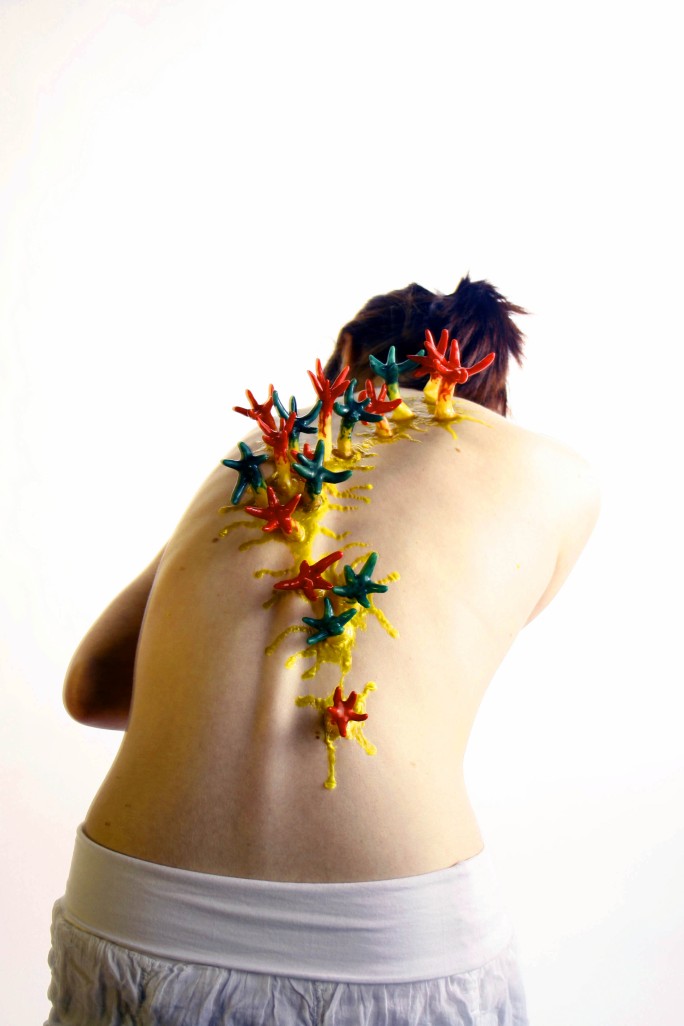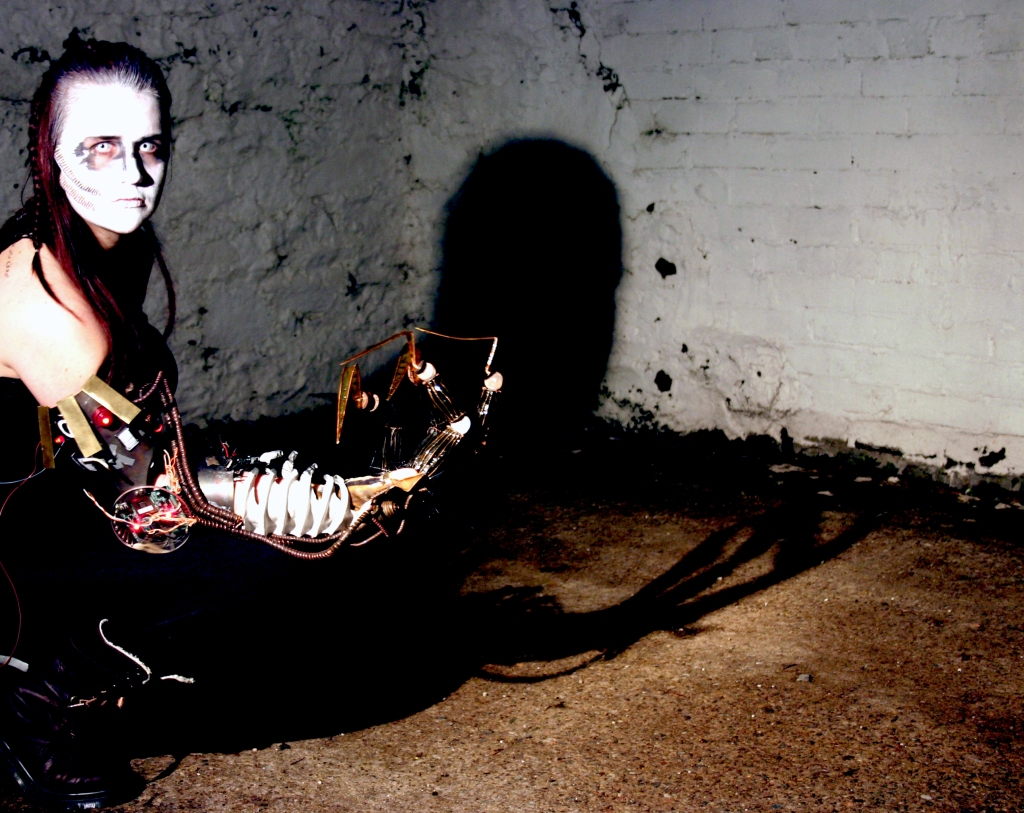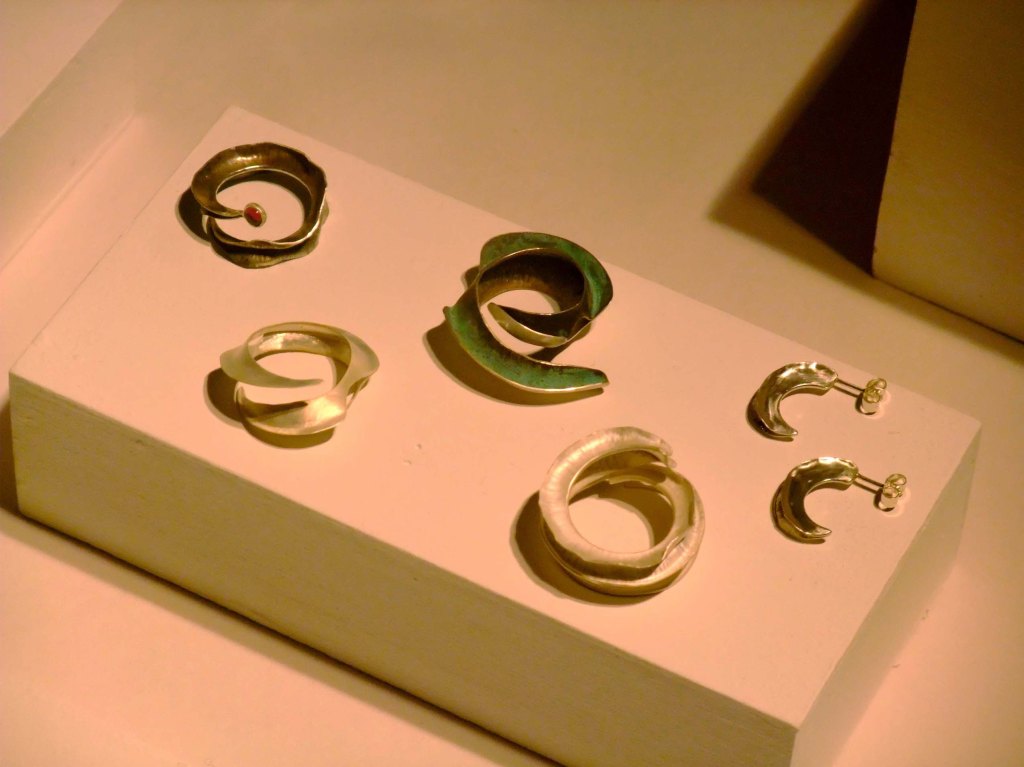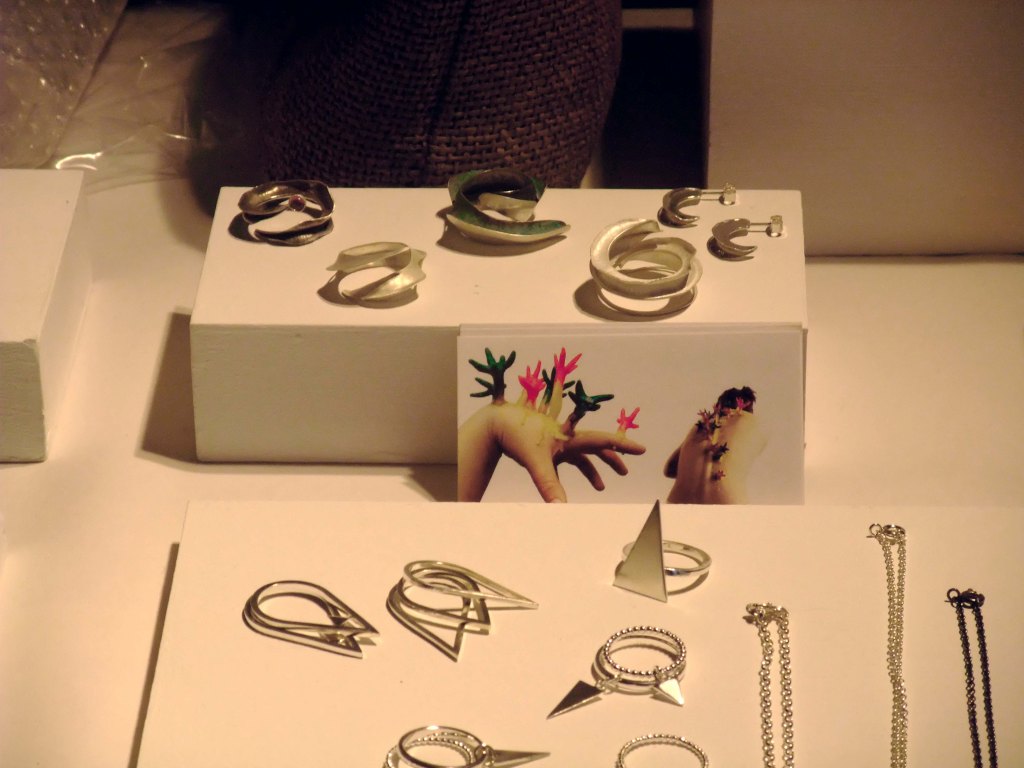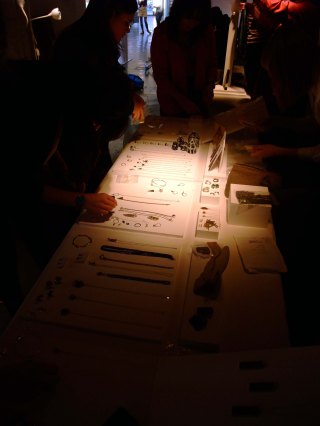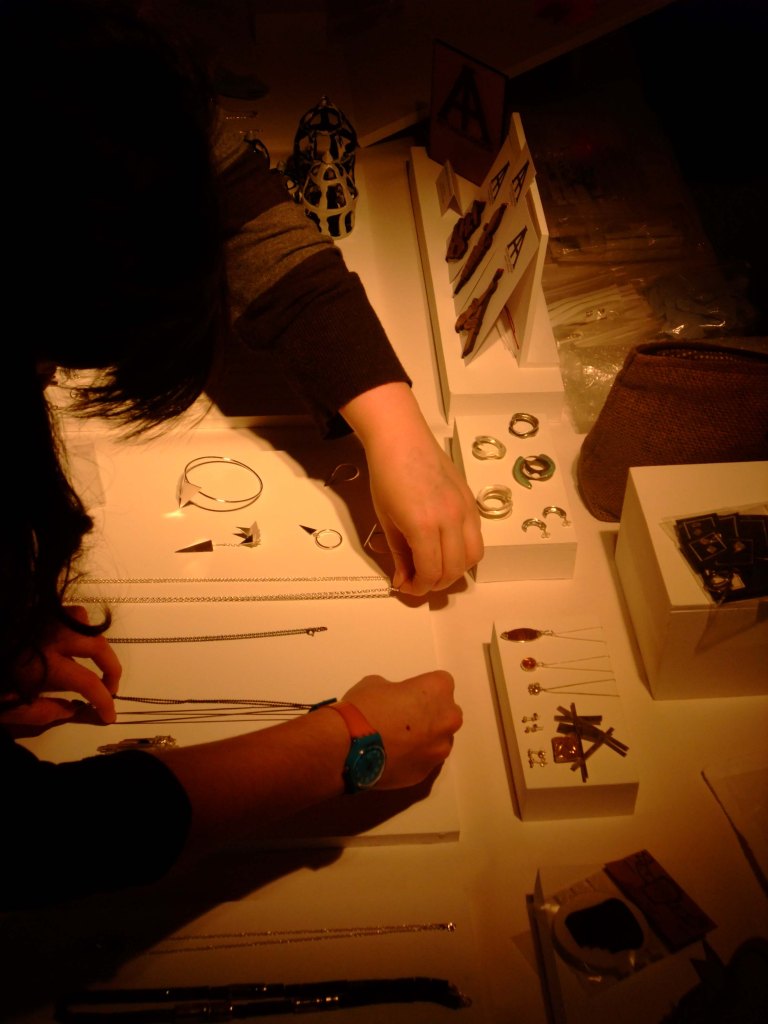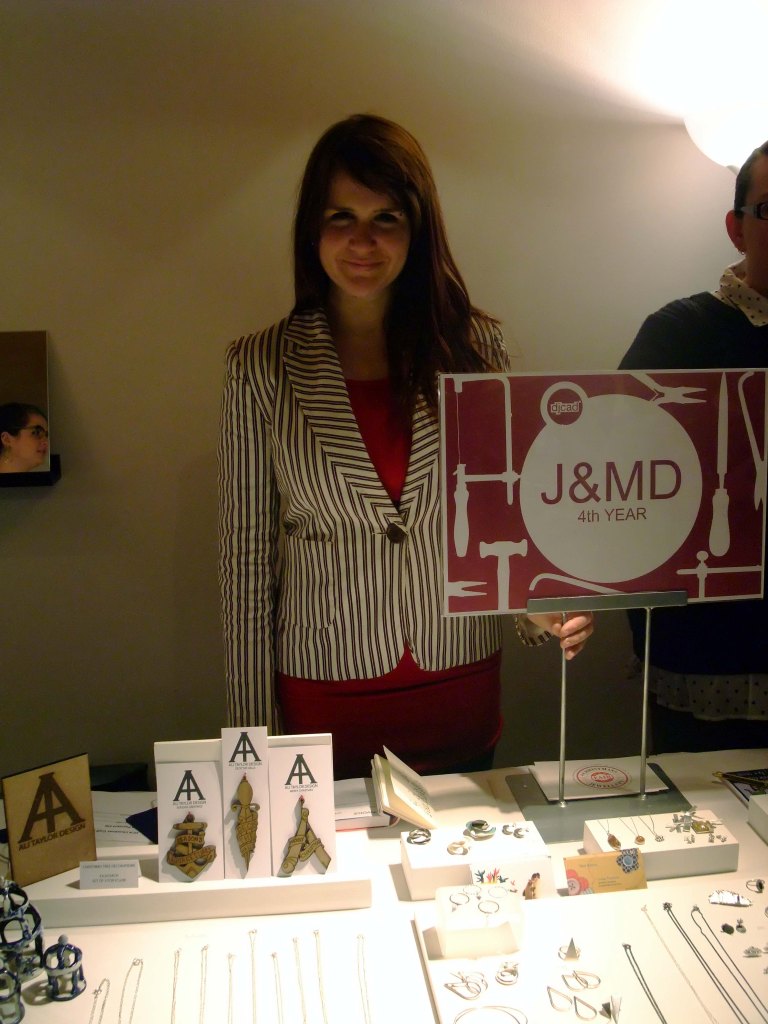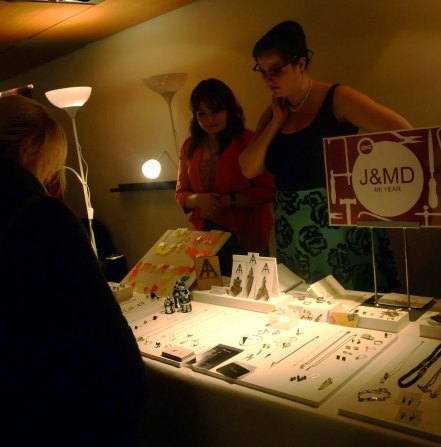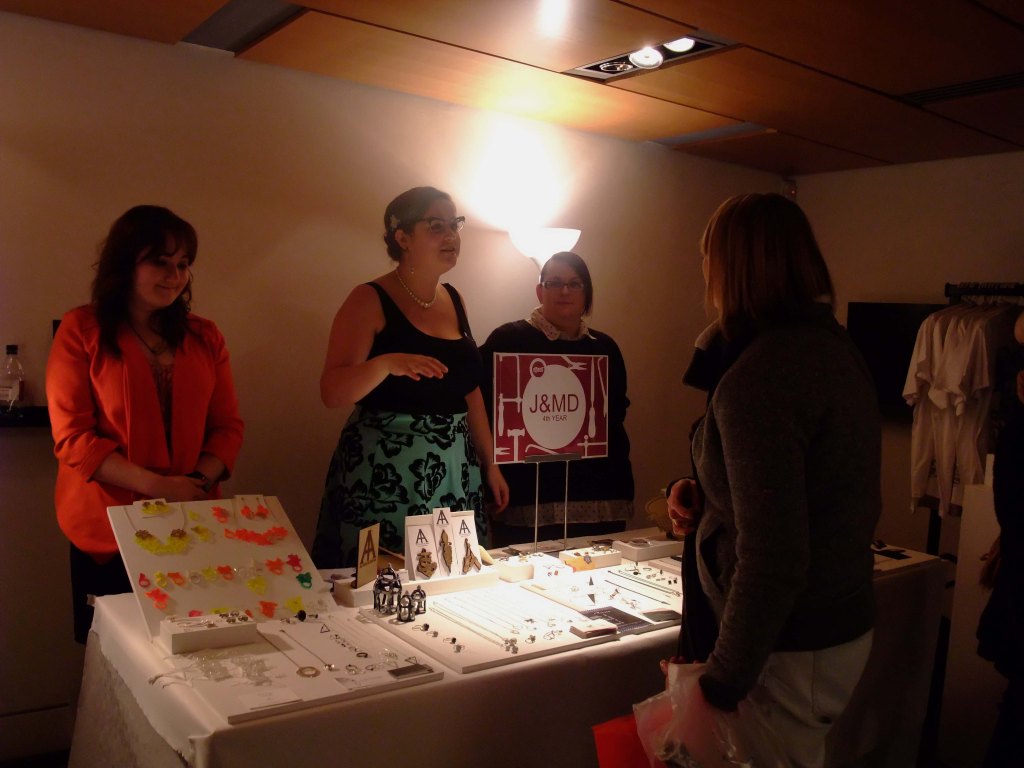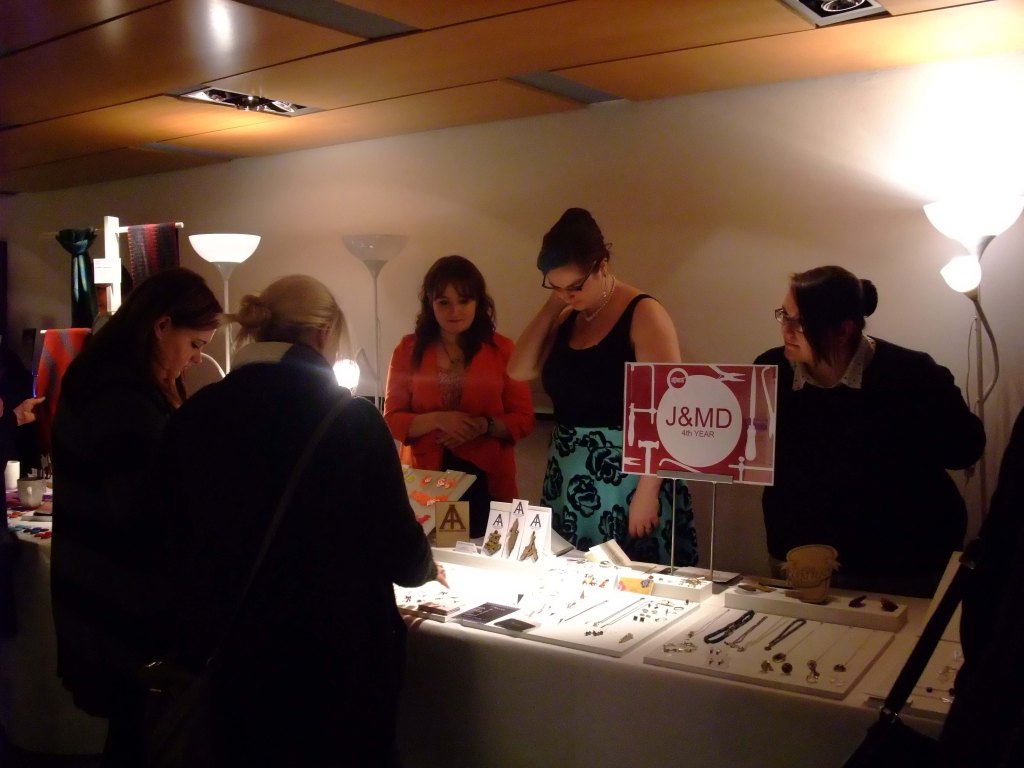Hello there, I’m a young enthusiastic creative prosthetics jewellery designer and maker and am struggling greatly to buy the materials I require to help me create an amazing Degree Show. So if you like my work, why not help by sponsoring me! I’ve got the skills, I’ve got the passion and the drive to make this happen, if only I had the materials to actually create my show-stoppers. For every pledge you will receive a reward and a huge thank you and all my social networking sites. Please follow the link to pledge: https://sponsorcraft.com/p/zoecreativeprostheticsjewellery/
Dundee Contemporary Arts (DCA) Christmas Market
I attended a Christmas Market on the 1st of December at the DCA, along with the rest of my final year jewellery class. Was a great learning curve! Organisation was definitely key for this. Thought about pricing, packaging, display and how to organise the money.
Here are some photos of us at work:
My pieces set up
Collaborative Alien Project: Who Are We?
Got my little butt into gear and finally plucked up the courage to ask Grant Herron (a fellow Jewellery student) about possibly collaborating as I heard he was into Film props. He was well up for it surprisingly so we went ahead and got started a couple of weeks later.
We decided to take our own interpretation on a Sci-Fi Film ‘Alien’ by Ridley Scott. Both of us thought we should create some kind of arm piece. Grant, being more experienced in electronics, designed the upper arm which consisted of small LEDs, a small rotating satellite dish and hinged parts. This is what I also wanted to learn from him. For me, well I went all out making a silicone corset forearm piece (as I’d never really played with the material before but was very keen to), a prosthetic glove with ribbed tubes and long hinged creepy fingers, all made from latex of course.
As we were both passionate about film, we discussed perhaps making a short film which would be able to present our piece on the body, moving and electronics in operation. For that we would need a storyboard:
My buddy filling in the storyboard
Here are photos from the making of our pieces:
Grant’s upper arm piece in the making. The circular piece with small tubes protruding from (right of picture) is the joint so I can allow movement like bending my elbow.
The satellite Grant made. Also some LED lights you were able to turn off and on.
This sequence of photographs is me attaching my prosthetic latex glove using Pros Aide glue. You can only really glue prosthetics in stages to make sure you have glued it on properly.
Still loose flapping bits of latex.
After repeatedly applying the glue all the latex should be attached to the skin with no loose parts.
Here is the whole of my lower arm piece put on. The fingers are divided into 3 and there are 2 hinged joints on each finger so they can move. The finger tips are square copper wire soldered together and I have created clear latex windows on each so light can pass through.
Below this you can see tubes extending down from the knuckles which are made from latex and copper wire and lastly the piece on the forearm is made from silicone.
The Silicone Piece
I had to create a mould in plaster to cast the silicone in. It is very weird and squishy to touch which I thought went well with the nature of this project.
The Facial Prosthetics
Just experimenting where it looks best. I thought it would look good to exaggerate the cheekbone.
Samples of prosthetics. They kind of look like slugs to me.
Attached only using the prosthetic glue. You can still see that the edges have not been blended with the skin but that comes next.
The beginning of the blending process… but you can see that later!
Here is me and Grant and a few other helpers on the set just setting and cleaning it up.
Day time
Night time
 My 20th time trying to put in contacts
My 20th time trying to put in contacts
Final Make-up
Midnight on the set. So so cold! Kept my dressing gown on as long as possible!
Just altering a wee bit
Final arm in the dark
Movie making in process
One of the Stop Motion pictures
Final scene
Such a good experience. Think we’ll be collaborating again for our final year as I think it is good practice for the future. You can learn a lot from each other and take things a step further. For me, I want to go into Prosthetics as I see it diminishing due to Computer Aided Graphics (CGI). Yes it can be extremely useful for big things but with it, you lose that sense of actually holding and feeling the object as it is all done on computer. Some makers use it because they are just being lazy and it saves time, but some actually use it for good purpose. For instance, in The Matrix when Neo dodges the bullets, that is a good example of well-used CGI.
Body Modifications & Prosthetics Survey
Please help me by filling out my short survey which I will use as part of my Business Plan. Thank you 🙂
Skin Prosthetics – The Future Fashion?
I am writing a proposal investigating whether skin prosthetics will become the new fashion.
Norman Cherry’s Skin Engineering
In the near future, I wish to engineer skin tissue so I can actually create real skin prosthetics. Professor Norman Cherry has already been able to do this and medics are beginning to see its potential. It may replace Teflon and silicone implants and is safer (due to the speculation of silicone implants being poisonous!). 
We have seen Lady Gaga with her facial prosthetics and Katy Perry in her E.T music video. So If anybody is reading this post could you please comment and tell me your views?
Would you wear skin prosthetics? If so, where would you like to wear them?
– Would this be likely aimed towards Body Modification fans? Or catwalk?
– Any suggestions to how I could get this out on the market? Conventions?
– How could I make prosthetics attractive towards more people? As the form of rings and forms of jewellery?
Any comments would be beneficial and much appreciated to use as part of my proposal.
Facial Prosthetics I created
Luminous Jellyfish
Another very experimental project, following from my Anemone Project, working with fluorescent pigments and ultra-violet light.
Again, my inspiration came from my diving background. In particular, remembering hopping off the boat to go snorkeling and as soon as I got comfortable in the water I saw, what looked like, 8 or so blueish parallel sticks standing vertically underwater. Was very odd. However, as I tried to figure out why they were standing so vertical I noticed there was some kind of clear plastic thing floating above it. I instantly realised that, from the plastic bags’ square shape, it was a Box Jellyfish. Only one of the most poisonous and deadly creatures in the world! As I hurriedly finned to the boat, I shouted “There’s a bloomin’ great big Box Jellyfish in here don’t get in!”
And knowing my dad, he thought it would be good to catch it in our cool box and bring it back to our local Yacht Club to show the kids why stinger/wet suits were so important. My dad actually got stung by one of these bad boys around the ankle.
Anyway, I love seeing how jellyfish move in the water and the different colours they come in. They tend to have luminous tendrils and things that can actually blink to both ward of predators and attract prey. I wanted to investigate ways in which to make colour glow so invested in a UV light bulb which worked wonders! By the way, if you are looking for a UV bulb do NOT get a UV Saving Lamp 75W ES that looks like this:
They might be cheap but they definitely don’t give off UV light just purple light. Just a rip off.
Get one of these Blacklight, ultra violet lamp, low energy BC/B22 Bayonet Fitting High UV light intensity 20W:
These are more expensive, at £9.50 a pop, but are worth the money.
Here are my final pieces. I want to develop this project and make hovering jewellery pieces that look like they are floating with the tide around the body. However, I was really tight with time so made them interior hanging objects.
The Great Thing About Making Bad Decisions
Such an inspiring book. ‘Whatever You Think, Think The Opposite’ is written by Paul Arden and made me feel great about the way I work. The book lets you in on how making bad decisions can lead to surprising achievements and rewards.
It explains that your bad decisions can actually influence others, for example, in the day, high jumpers used to jump over the bar front first – almost like a forward roll. This was called the Western Roll.
However in the 1968 Mexico Olympics a guy called Dick Fosbury approached the bar but turned his back on it, flipping his legs up from behind him – beating all the other athletes by miles. This is called a Fosbury Flop and is now used by everyone.
Just shows that making a daring decision can have great impact.
“The problem with making sensible decisions is that so is everyone else”

Another really funny story is explained of an Oxford professor bathing naked in a river. He was getting out when a boat of undergraduates floated by. In sheer panic he went for his towel and wrapped it around his head. The bottom line is he would rather conceal his identity than being humiliated!
Arden points out that showing people your work is a good way in getting constructive criticism. However, do not ask them what they think about it, as they will probably say everything positive – not wanting to offend. The only way to get great constructive criticism is to ask them what is wrong with the work and give them permission to give truthful comments – accept the comments and do not fight back! This is key in developing work, amending the problems and most importantly gaining strength in what you do.
“Be your own worst critic. When things go wrong, it’s tempting to shift the blame. Don’t. Accept responsibility. People will appreciate it, and you will find out what you’re capable of.”
Arden illustrates that having too many ideas is not always good. You tend to become flustered and do not finish things to their utmost potential because you have something ‘better’. Maybe having fewer ideas are better so you become more focused and work harder on each of them – making the most of the ideas you have.
This book is really motivating as when I work I usually take risks, however, I’m also thinking it might be better just to go down the safer route. But a little of me thinks – “that does not get people talking about your work, it’s not exciting to be safe”. It is the same when you go into a gallery and see something full of sexual content and quite disturbing. You end up talking about it throughout the whole gallery saying how obscene it is. Even when you exit the building you tell your friends about it. TELLING THEM ABOUT IT. This is the way it has effected you. The image has remained stuck in your brain. Memorable. This is what taking risks is all about. Taking things over the edge. So yes risk-taking creatively is something I truly believe in.
Leaving on one of my favourite inspirational quotes, he concludes:
“The world is what you think of it. So think of it different and your life will change”
Sea Anemone Project
My family are all scuba divers. I love being under the water it’s such a magical place! Feel like a mermaid. It’s brilliant. When I’m under I usually tend to touch things. It’s tempting when there’s colourful little feathery crawlies and wobbly jellies. Once, I got so into it I actually rubbed my face against a sea anemone and it ended up stinging me all over! Ouch. Yes – tip for today: maybe don’t touch things when you haven’t got a clue what it is. Following on from that, I based this project on sea anemones.
They are amazing underwater jellies that possess long wobbly tentacles which wave with the tide. Their colours are vibrant and can usually in groups competing for light just like land plants would do. I really wanted to capture this sense of cluster growth and bright colour, in addition to their strange jelly quality. Here are some of my sketches illustrating their bulbous forms, colour and alien-like features. Be prepared, some of them can be a bit… well, a bit suggestive in shape.
The last picture was my first sample in which I created 3-dimensional crevasses and little hints of colour. I was very pleased with the result as allowed me to think of all kinds of shapes – the possibilities seemed endless! I even got excited about colour as you will see in my more developed samples below.
Once I got the hang of creating colourful alien-like forms. I tried envisioning pieces on the body. I took inspiration from the designers Lucy Mcrae & Bart Hess and Mi-Mi Moscow. They are both collaborative designers who make creative pieces adorned uniquely on the human form. I like adorning the body in unusual ways because I like morphication and changing the normal shape of the body. Almost like transforming people into underwater creatures themselves. This was my idea.
I wanted to emphasise growth and re-creating the human form. My final outcomes are a mix between final photographs and pieces, aimed to capture unfamiliar shapes and strange alterations to the body.
For my first solution I attached anemone tentacles to the ends of fingers – changing the length and proportion of the fingers to the rest of the body.
Next I created a simple ring with which protrude rather suggestive tentacles. I liked the contrast of the smooth reflective metal to the rubbery matt texture of the latex. The benefits of this ring is you can put on your jacket without worrying about the tentacles breaking off as they are extremely flexible.
Finally I transformed the shape of the back into a kind of extending dorsal fin. Little anemone branches sprout from the surface down the spine as if they were spreading. Long roots stretch across the back to stress this idea of hosting and the ‘taking-over’ of the body.
Next I’ll be looking at making luminescent creatures and incorporating bits of wire to make them look more intricate and delicate. Thanks for checking out some of my work!
Design & The Market: Me Choosing My Path
Oh dear. So yes – putting life in my hands. Today in our Design Market group we looked at choosing the path we would take into achieving our potential business. What you need to think about to make it a sustainable and successful one. Scary stuff.
To begin with, we had a look at our ‘would-be’ customers and wrote down a list of the customer groups they would be. For example: Students; Fashion Runway Buyers; Hospital Buyers; etc. For each one we had to outline what their needs would be, what we would be offering them, how many there are, and so forth. Through this method of analysing our future customers it helps to see if your business has potential and whether it is actually needed. For my business, I found a number of different customer groups which I think is good because it brings range and excitement of varying customers. However, I think I would need a rather large team to back me up on the amount of work I would need to do!
Next, we headed into the Blueprinting Modelling sector. This, I found, was the most difficult. Just couldn’t get my head round where to put things! Blueprinting is a detailed flow diagram of your business’s stages in carrying out, for example, a commission piece. It just shows how your business will function when it’s actually doing business. For me, I looked at where I would go to create contacts then try get some of my work out to the public somehow, find people to work with me and so on. Sounds do-able. This allowed me to view the process of my hopeful business at hand. How it might work. How I can change it tomake it work.
Lastly, we looked at the importance of building relationships in business. Not lovey-dovey ones, professional team-work ones. It is important because it makes all stages in the process work. Imagine doing it all yourself? We focused on the four areas of activity in business. The Generator, the Realiser, the Distributor and the Customer. We had to find people we would need for each of the areas. I placed myself in the Realiser zone, as well as other collaborators, because I feel that is where my strengths lie. However, I would over-see other areas frequently. This exercise allows me to see who I would need to build relationships with and it’s importance. Building relationships improves and makes your business stronger. More sustainable. You just need to make sure there is plenty of trust and that they love the business as much as you do.
These exercises were helpful in outlining how my business would operate, create contacts/clients and who I would need to make it happen. Building relationships crops up again and again. It seems now that who you know can help greatly in business – like the old saying: “It’s not what you know, it’s who you know”.
Design & The Market: Evidence Modelling
Evidence Modelling
Today in our Design & Market Module, we were asked to look at evidence modelling. Evidence modelling is about creating a picture of what your potential business would be like in the future and aiding in giving a clear direction of where to go with it. It focuses on 4 extreme questions to ask when considering your business – this helps to understand the beneficial impact of your business but also can point out the possible mistakes that can stop you from achieving your dream.
This exercise helped me to think about the advantages and disadvantages my business may have in greater depth. It made me focus on what ways I could improve the business and to see it more realistically in my mind. However, my potential business needs huge development and research as it looks into the future of jewellery trends more than actual current designs. It will be an interesting challenge.
Fake Evidence
For the next exercise we had to think of fake evidence. This is where we had to construct evidence through imagining the future success of our business. This could be in the form of a website, an advert on the side of a bus, etc. I went for a few as I believe my market is quite wide.
 Just a very very rough sketch!
Just a very very rough sketch!
Through investigating the future success and methods of advertising it helps see the consequences of the business as well as looking into successful ways to get the brand out there.
SWOT Analysis
SWOT analysis was the last task we had to complete for our business. There were 4 boxes outlining different aspects to think about the business: Strengths and Weaknesses (Internal); Opportunities and Threats (External) or SWOT. It allows us to examine the business’s position nature. This task helped me because I tried to think about turning all the weaknesses into possible opportunities. For instance, if I was bad at making film I could maybe collaborate with a filmy person, thus, creating a huge benefit! We could expand making more exciting films and let ideas bounce off one another.
All these exercises linked back to our Mission Statements and was great because it makes us think that we could actually do this. We could actually make our potential businesses real.

